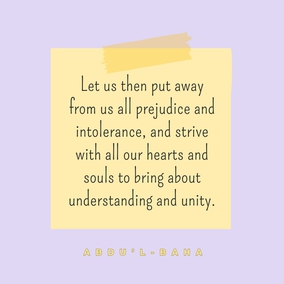The views expressed in our content reflect individual perspectives and do not represent the authoritative views of the Baha'i Faith.
Examining closely the opposites all around us, we notice they eventually overlap, merge, and form a greater whole.
Similarly, moving closer to fulfilling our own potential, the veils of illusion burn away as we witness the divine in everything, and the entire Creation in a single glance. All along, evolution has led us toward this unfolding harmony and unity.
This hidden wholeness removes artificial boundaries between all things, as in a systems view of the world, where everything is understood as interconnected, coming together in a “grand synthesis.” Even evolution itself can be seen as an interconnected whole, which unites physical, biological, and social evolution, because all express the same universal laws, patterns, and principles.
As these boundaries have softened, so have the boundaries between faith traditions softened and begun to merge. We can trace this trend back to the mid-late 19th century, or perhaps the first Parliament of the World’s Religions in 1893, considered the birth of the global interfaith movement.
That one event initiated the creation of circumstances that made the time ripe for a shift in consciousness toward considering the whole of religion rather than just its parts in isolation. A number of other new global interfaith organizations followed the Parliament, such as the Vedanta Society in 1894; the World Congress of Faiths in 1936; the Temple of Understanding in 1960; and the United Religions Initiative in 1993. All of this made the time right in 1999 for Brother Wayne Teasdale to announce in The Mystic Heart: Discovering a Universal Spirituality in the World’s Religions that we are at the dawn of a new consciousness, the beginning of what he called the “Interspiritual Age.” This signaled a step beyond the interfaith age, because it acknowledged a spiritual interdependence among the world’s religions and faith traditions.

Temple of Understanding 1960
In the 21st century, we have seen a mounting continuation of this trend, with even more multi-faith organizations and interfaith seminaries coming into being. In 2002, the Universal House of Justice, the international governing council of the Baha’i Faith, issued a statement addressed to “The World’s Religious Leaders,” opening with the observation that events of the twentieth century have “compelled the peoples of the world to begin seeing themselves as the members of a single human race, and the earth as that race’s common homeland.”
The Universal House of Justice explained further:
A threshold has been crossed from which there is no credible possibility of return. Fundamental principles have been identified, articulated, accorded broad publicity and are becoming progressively incarnated in institutions capable of imposing them on public behaviour. There is no doubt that, however protracted and painful the struggle, the outcome will be to revolutionize relationships among all peoples, at the grassroots level.
This statement has its source in the words of Baha’u’llah of more than a century ago:
There can be no doubt whatever that the peoples of the world, of whatever race or religion, derive their inspiration from one heavenly Source, and are the subjects of one God. The difference between the ordinances under which they abide should be attributed to the varying requirements and exigencies of the age in which they were revealed. – Baha’u’llah, Gleanings from the Writings of Baha’u’llah, p. 217.
The implication of this principle of the oneness of humanity and of religion should not call into question one’s “faith in the fundamental verities of any of the world’s great belief systems,” but rather allow us to let go of all “claims to exclusivity or finality,” the religious dogmas that lead to hatred and violence.
This Baha’i principle of the essential oneness of religion, instead, encourages a deeper exploration of humanity’s common spiritual heritage—an expression, the statement adds, of “the principle of religion’s evolutionary nature.” This Baha’i statement challenges the interfaith movement to seriously consider the implications of this oneness:
Interfaith discourse, if it is to contribute meaningfully to healing the ills that afflict a desperate humanity, must now address honestly and without further evasion the implications of the over-arching truth that called the movement into being: that God is one and that, beyond all diversity of cultural expression and human interpretation, religion is likewise one.
Baha’is believe that the interspiritual age will only come into full existence when humanity finally and fully recognizes its oneness, when we realize our union with all of creation, and when we put this consciousness into action. That has already begun to happen.
You May Also Like
Comments

















and is what should unify.